
Eng-phon-indx

by U Kyaw Tun (UKT) (M.S., I.P.S.T.,
USA), Daw Khin Wutyi, Daw Thuzar Myint
and staff of Tun Institute of
Learning (TIL) . Not for sale.
No copyright. Free for everyone.
Prepared for students and
staff of TIL Research Station,
Yangon, MYANMAR
-
http://www.tuninst.net ,
www.romabama.blogspot.com
- based on Peter Roach, English Phonetics and Phonology, a practical course. 2nd ed., 4th printing 1993, Cambridge University Press. ISBN 0-521-40718-4. pp 262 . For my reference, the printed book was digitized by Daw Khin Wutyi, B.Sc., TIL Research Station, Yangon, MYANMAR. Page references to the original book are shown in my text for easy reference.
UKT 110223, 121201, 150107: The main reference for this presentation is the book by Peter Roach, the senior editor of DJPD16 - Daniel Jones English Pronouncing Dictionary 16ed., 2003. I have also looked into two other sources:
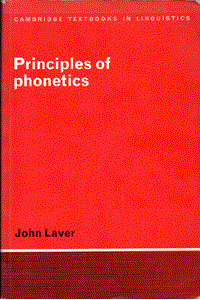
� John Laver, The Phonetic Description of Voice quality, Cambridge Univ. Press, 1980. and Principles of Phonetics, 1994, pp707 .
� Peter Ladefoged, Vowels and Consonants, 2nd ed., Blackwell Publishing, 2005, pp206
My presentation is also based on my understanding of Bur-Myan (Burmese-Myanmar) - my L1 the first language, and some of Pal-Myan (Pali-Myanmar), Skt-Dev (Sanskrit-Devanagari) languages. I have added material from many other sources. However, in this edition I will try to follow Roach's presentation as closely as possible. My rewriting could introduce unintentional errors of which I alone am responsible.
index.htm |
Top
Eng-phon-indx.htm
UKT 170910: When I come back to this site after a few years of learning more of Mon-Myan, Pal-Myan and Skt-Dev, I've found what I had known about English Phonetics and Phonology has to entirely revised: even the very first page, p.003 on Introduction is taking time beyond what had been expected.
Introduction
- intro.htm -
update 2017Sep Nov
Production of English sounds -
prod-snd.htm - to be updated
English consonants and vowels -
con-vow.htm - to be updated
English short vowels -
short-vow.htm - to be updated
English long vowels -
long-vow.htm - to be updated
English diphthongs and triphthongs -
diphth.htm - to be updated
�
Notes on problems and further reading
�
Notes for teachers
Note: Inclusions by UKT are marked [...].
UKT notes
�
Doggie's Tale : copy and paste
� Extension
of IPA for interlanguage study of BEPS
�
Mappings of BEPS consonants
�
Mappings of BEPS vowels
� POA - the Places
of Articulation (pictorial)
�
Stress in English pronunciation
� Vedic Sanskrit
Noteworthy words in this file :
� Because of the notoriously confusing
nature of English spelling it is particularly
important to learn to think of English
pronunciation in terms of phonemes rather
than letters [{graphemes}] of the alphabet.
� [Peter Roach:] This course is not written
for people who wish to study American
pronunciation.
[UKT: However, I have to include the American
pronunciation as well. - 110213]
Contents of this page
p.003
UKT 070911: The following are to be moved after rechecking to a new page "Introduction".
(p003cont)
[UKT � ]
-- vowels
![]() {�a.ra.}, consonants
{�a.ra.}, consonants
![]() {by��:}, phonemes
{by��:}, phonemes
![]() {��n-ring:} {sa.ka:aim}, and the syllables
{��n-ring:} {sa.ka:aim}, and the syllables
![]() {w�N~Na.} formed by combination of phonemes
in the canonical form CVC
(consonant-vowel-consonant), for example,
{w�N~Na.} formed by combination of phonemes
in the canonical form CVC
(consonant-vowel-consonant), for example,
� words <pin> /pɪn/ and <pen> /pen/ are different because of rimes /ɪn/ and /en/
� words <pit> /pɪn/ and <pet> /pet/ are different because of rimes /ɪn/ and /et/
UKT: Western authors usually do not pay attention to the differences due to where is the consonant is situated. They do not emphasize the difference of the onset-consonant (consonant in the onset position), and the coda-consonant (consonant in the coda position) in the pronunciation of the syllable as a whole. However, in Bur-Myan we have to point out the special case of the coda-consonant with a 'diacritic' known as the Virama
{a.��t}. The problem of transcription between Burmese and English is compounded because Eng-Lat does not have all the nasal
{na-�i.ka.} consonants of Bur-Myan.
� English has only two: (r5c5) /m/
{ma.}; (r4c5) /n/
{na.}
� English lacks basic Bur-Myan: (r3c5)
{Na.}; (r2c5)
{�a.}; (r1c5)
{gna.} :
I'm beginning to doubt if these could be rightly called nasals at all. IPA does not transliterations for these three: for pronunciation just go by Romabama transcription. Note: There is a difference Bur-Myan{�a.}, and Pali-Myan
{�a.}.
Bur-Myan{�a.} can stand being under
{a.��t}
{�},
whereas Pali-Myan{�a.} breaks up under
{a.��t} into
{�}~
{�a.}
� What English has are the killed (codas) /ɳ/
{N}; /ɲ/
{�}; /ŋ/
{ng}
Because of this paucity of nasals in English, transcription of words ending in nasals is a hassle. For example <pin> /pɪn/ cannot be transcribed into Bur-Myan without changing the English coda. Sometimes, it becomes necessary to change the vowel as well: <pin> /pɪn/ is loosely transcribed in Bur-Myan as
{ping} which in IPA is /pɪŋ/.
The difficulty in finding a reliable transcription is also due to the absence of the hissing dental fricative in Bur-Myan. This phoneme is represented in Skt-Dev ष �ṣa�. We should note that this phoneme was probably not presented in the pre-Sanskrit languages, because ष �ṣa� appears to have been borrowed from प �pa� and a short "diagonal line" line added. For my transcription in Romabama I have borrowed from Bur-Myan palatal plosive-stop
{sa.}/
{c} and have written
{Sa.} /
{S}. Caution: the parent glyph is the same for both palatal
{sa.} and dental
{Sa.} - the difference is only in the "killed" derivative,
{c} &
{S}.
� words <pet> /pet/ and <bet> /bet/ are different
because of onset-consonants <p> /p/ and <b> /b/ .� words <spit> /spɪt/ and <pit> /pɪt/ are different
because of onset-consonants <sp> /sp/ and <p> /p/ .UKT: English spelling has consonant clusters like <sp> <st> and <sk> which are difficult to pronounce for a Bur-Myan. I had not realized that the English <s> is not palatal
{sa.}, but the dental
{Sa.}. Incidentally, you cannot avoid pronouncing the English <ice cream> which involves the <sk> sound. I have found a way to teach it. Start with <sp> as in <spin>. All the Bur-Myan I have taught can pronounce this sound slowly at first. Then pronounce it more rapidly, then you will find you can pronounce it. Practice this for a few times, and then proceed to <st> in <stin> or <stingy>. Again practice for a few times. Finally go to <sk> in <skin>. The order of this method is always: <sp>, <st>, <sk>.
Another well-known consonant-cluster is <kn> in <knee> which the English speakers themselves could not pronounce. This is because /k/ as a velar phoneme has a POA (Point of Articulation) far removed from /n/ as the dental-alveolar. (See my note on POA pictorial.) To pronounce this consonant cluster, the tongue body and tip would require to do movements which are not humanly possible. The result is the English speaker simply ignores the /k/ and pronounce <knee> /niː/ as similar to <nee> /neɪ/ . In this case <k> becomes silent. A less well-known case is the "silent b" in <plumber> /plʌm.əʳ/ where the /b/ is ignored. The pronunciation is /<plumer>/.
English and other European languages do not have the two classes of consonants that are very important in Bur-Myan and Indic languages. They are in columns 2 and 4, headed by
{hka.} and
{Ga.} in Bur-Myan and Pal-Myan wag-akshara matrix. These two classes are dubbed by Western authors as "aspirated", and they add an <h> after the main letter:
<k> --> <kh> and
<g> --> <gh>.IPA, developed in the West, does not have dedicated symbols for these and have to give /kʰ/ and /gʰ/ . Because of this I am forced to extend the IPA for study of BEPS. See my note on extension of IPA .
(p003cont)
Because of the notoriously confusing nature of English
spelling it is particularly important to learn to think
of English pronunciation in terms of phonemes (![]() {��n-ring:}) [or sound] rather than the way you write it. The way
you write in letters
{��n-ring:}) [or sound] rather than the way you write it. The way
you write in letters
UKT: Speakers of Burmese particularly those who are able to write in Myanmar should never forget that English is written in Latin script. Eng-Lat is an alphabet, whereas Bur-Myan is an abugida. aka alpha-syllabic .
I must emphasize that alphabet and abugida (also known as alpha-syllabic script) are not the same. This is a point missed by MLC which continues to call akshara an alphabet. See MLC MED2006-619
Eng-Lat is non-phonetic whereas Bur-Myan is, and therefore it is possible to have a one-to-one mapping to IPA. Because of this, it is theoretically possible to use Myanmar akshara to teach English. However, it is found that if an intermediate script, such as Romabama (Bur-Lat), were used as an intermediate script the task becomes easier. Note: Romabama had started out primarily a transliteration from Bur-Myan, however I am convinced that by now (121201) it is a full-fledged transcription and I have been able to go through A. A. Macdonell's A Practical Sanskrit Dictionary entry-by-entry comparing the entries to U Hoke Sein's Pali-Myanmar Dictionary (in Bur-Myan). -- UKT 121201
(p003cont)
The first part of the course is mainly concerned with
identifying and describing the phonemes of English.
Chapters 2 and 3 deal with vowels and Chapter 4 with
some consonants. After this preliminary contact with
the practical business of how some English sounds are
pronounced (p003end-p004begin), the fifth chapter looks
at the phoneme and at the use of symbols in a theoretical
way, while the corresponding Tape unit [UKT: tapes are
not available] revises the material of Chapters 2-4.
After the phonemes of English have been introduced, the
rest of the course goes on to look at larger units of
speech such as the syllable and at aspects of speech
such as
stress
(which could be roughly described as the relative strength
of a syllable) and intonation (the use of the pitch
of the voice to convey meaning). It would be a mistake to
think that phonemes are studied first because they are
the most important aspect of speech; the reason is simply
that, in Roach's experience, courses which begin with
matters such as stress and intonation and deal with phonemes
later are found more confusing by the students who use them.
You will have to learn a number of technical terms such as phoneme, phonetics and phonology. They are written in bold type the first time they are introduced. Another convention to remember is that when words used as examples are gives in spelling form, they are enclosed in single quotes (e.g. 'pin', 'pen', etc.) by Roach. However, I, UKT, has to rewrite them in angle brackets, e.g., <pin>, <pen>, etc. Double quote marks are used where quote marks would normally be used; see, for example, "English Pronunciation" above.
UKT: Romabama uses a slightly different convention which I, UKT, have followed in my notes and additions.
� <...> - regular English letters and words
� �...� - IAST transliteration. Caution: do not pronounce it as in regular English.
� {...} - Romabama -- uses extended Latin
� /.../ - IPA phonemic or broad transcription
� [...] - phonetic or narrow transcription - this will be changed to /.../ to include approximate pronunciations across languages of BEPSRomabama does not confine itself to Eng-Lat graphemes only. To increase the number of characters, it uses letters of extended Latin alphabet, as long as they are in ASCII (American Standard Code for Information Interchange). Moreover, the small letters and capital letters are considered to be independent of each other, for example, <but> /bʌt/ spelled as
{b�t} or
{B�t} to be differentiated from <put> /pʊt/
{pwut}.
(p004cont)
Languages have different accents: they are pronounced
differently by people from different geographical places,
from different social classes, of different ages and different
educational backgrounds. The word "accent" is often
confused with dialect. We use the word "dialect"
to refer to a variety of a language which is different from
others not just in pronunciation but also in such matters as
vocabulary, grammar and word-order. Differences of accent, on
the other hand, are pronunciation differences only.
Though this course was not written by Roach for people who wish to study American pronunciation aka (also known as) GA (General American), I find it necessary to include it. The accent that we concentrate on and use as our model is the one that is most often recommended for foreign learners studying International English which might be considered to be a hybrid of RP (Received Pronunciation, BBC English, or British accent) and GA. It is most familiar as the accent used by most announcers and newsreaders on serious national and international BBC broadcasting channels and American channels. The pronunciation of English in America is different from most accents found in Britain. There are exceptions to this - you can find accents in parts of Britain that sound American, and accents in America that sound British. But the pronunciation that you are likely to hear from most Americans does sound noticeably different from RP.
In talking about accents of English, you the second-language (L2) learner, should know the difference between England and Britain; there are many different accents in England, but the range becomes very much wider if the accents of Scotland, Wales and Northern Ireland (Scotland and (p004end-p005begin) Wales are included. These areas are all parts of Britain. Include Northern Ireland and you must call it the UK (United Kingdom)) and not Britain. Within the accents of England, the distinction that is most frequently made by the majority of English people is between Northern and Southern. This is a very rough division, and there can be endless argument over where the boundaries lie, but most people on hearing a pronunciation typical of someone from Lancashire, Yorkshire or other counties further north would identify it as "Northern".
Though this course deals almost entirely with RP as far as "British English" is concerned, there is, of course, no implication that other accents are inferior or less pleasant-sounding; the reason is simply that RP is the accent that has always been chosen by British-English teachers to teach to foreign learners (as in Burma and India during British colonial occupation), and is the accent that has been most fully described and has been used as the basis for textbooks and pronouncing dictionaries.
As a Bur-Myan what you have been taught in Myanmarpr� is supposed to be RP. But people will stay you sound Burglish. Keep your own accent, but notice the difference from RP and GA you will hear on the international radio and TV. Roach does not, of course, suggests that you should try to change your pronunciation to RP! As an L2 learner of English you are recommended to concentrate on RP initially.
(p005cont)
[Roach and I] feel that if we had a completely free choice of
model accent it would be possible to find more suitable ones:
many Scottish and Irish accents, for example, have a much more
straightforward relationship between spelling and sounds than
does RP, and have simpler vowel systems, and would therefore
be easier for most foreign learners to acquire. Unfortunately,
the majority of English teachers in Britain and elsewhere
would be reluctant to learn to speak in the classroom with
such an accent, so this is not a practical possibility. This
is the basis of my conviction that a so-called
"native-speaker of English" teaching English in Myanmarpr� is not as effective as is commonly thought in my mother-land.
For introductory reading on English pronunciation, Roach suggests: see O'Connor (1980), pp.5-6; Brown (1990), pp. 12-13; Gimson (1989), pp.83-8. For a discussion of the status of RP, see Abercrombie (1965). For those who want to know more about British accents, a simple introduction is Hughes and Trudgill (1987); undoubtedly the major work on all accents of English is Wells (1982), which is a very valuable source of information (see especially pp. 117-18 and 279-301 on RP). A recent book that has caused a certain amount of controversy is Honey (1989) (p005end-p006begin), which discusses the importance of accents (and RP in particular) in education, politics and social life. Roach disagrees with many of the views expressed, but the book is interesting to read.
A problem area that has received a lot of attention is the choice of symbols for representing English phonemes. The symbols used by Roach in his book are in almost every respect those devised by A. C. Gimson for the English Pronouncing Dictionary (14th edition). [However, I, UKT, rely entirely on DJPD16 (Daniel Jones Pronouncing Distionary 16the ed.)]
(p006cont)
Pronunciation teaching is not popular all the time with
teachers and language-teaching theorists, and in recent
years it has been fashionable to treat it as a rather
outdated activity. It has been claimed, for example, that
it attempts to make learners try to sound like native
speakers of RP, that it discourages them through difficult
and repetitive exercise and that it fails to give importance
to communication. A good example of this attitude is to be
found in Brown and Yule (1983), pp. 26-7. The criticism is
misguided, Roach believes. No pronunciation course that he
knows of has ever said that learners must try to speak
perfect RP, to claim this mixes up models with goals: the
model chosen is RP, but the goal is normally to develop the
learner's pronunciation sufficiently to permit effective
communication with other English speakers across the world.
Pronunciation exercises can be difficult, of course, but if
we eliminate everything difficult from our teaching, we may
end up doing very little beyond getting students to play
little communication games. It is, incidentally, quite
incorrect to suggest that the classic works on pronunciation
and phonetics teaching concentrated on mechanically perfecting
vowels and consonants: Jones (1956), for example, writes
" 'Good' speech may be defined as a way of speaking
which is clearly intelligible to all ordinary people,
'Bad' speech is a way of talking which is difficult for most
people to understand ... . A person may speak with sounds
very different from those of his hearers (p006end-p007begin)
and yet be clearly intelligible to all of them, as for instance
when a Scotsman or an American address an English audience
with clear articulation. Their speech cannot be described as
other than 'good'."
There are many different and well-tried methods of teaching and testing pronunciation, many of which are used in this book. Roach does not feel that it is suitable in this book to go into a detailed analysis of these methods, but there is an excellent treatment of the subject in Kenworthy (1987) . Gimson (1989) also discusses pronunciation teaching ( chapter 12 ), and Brown and Yule (1983) contains some interesting ideas. (p007end)
-- UKT 130613
Mnemonic
The Doggie Tale:

Little doggie cringe in fear -- ŋ (velar),
Seeing Ella's flapping ears -- ɲ (palatal)
And, the Shepard's hanging rear -- ɳ (retroflex).
Doggie so sad he can't get it out
What's that Kasha क्ष
when there's a Kha ख ?
And when there's Jana ज्ञ
what I am to do with Jha झ?
On top of all there're husher and hisser, Sha श /ʃ/ and Ssa ष /s/,
when I am stuck with Theta स
/θ/ !"

Little Doggie don't be sad,
You are no worse than a Celtic Gnome
Losing G in his name, he is just a Nome!
Note to digitizer: you can copy and
paste the following:
Ā ā ă ấ Ē ē ĕ ế Ī ī ĭ Ō ō
ŏ Ū ū ŭ ː
Ḍ ḍ Ḥ ḥ Ḷ ḷ Ḹ
ḹ Ṁ ṁ Ṃ ṃ
Ṅ ṅ
� � Ṇ ṇ ɴ Ṛ ṛ Ṝ ṝ
Ś ś Ṣ ṣ Ṭ ṭ ɕ ʂ
Book marks: * star, � dagger (alt0134), � double dagger (alt0135).
Bur-Myan: for {gna.}-onset use c ċ (U010B) - unfortunately ċ is non-ASCII
� Instead of Skt-Dev ः {wic~sa.} use "colon" :

� Avagraha ऽ use apostrophe
� Root sign √ ; approx ≅
� IAST Dev: भ आ इ ई उ ऊ
ऋ ऌ ऍ ऎ ए ऐ
ऑ ऒ ओ औ
च �ca� छ �cha� श
ś [ɕ] /ʃ/ ; ष ṣ [ʂ] /s/;
स s [s] /θ/ ;
ऋ {iRi.} & ॠ {iRi},
viram ् , rhotic ऋ ृ
� Skt-Dev Row #3: ट ठ ड ढ ण ;
conjunct ट ् ठ
= ट्ठ
� IAST Dev: Repha & Viram-position,
e.g. तर्ज �tarj� [ targ ] = त र ् ज
� Skt-Dev special phonemes: Ksa क ् ष
= क्ष
� Undertie in Dev transcription: ‿ U203F
� Using ZWNJ (ZeroWidthNonJoiner), e.g. ,
क्ष
(code: क्‌ष)
See Wikipedia:
https://en.wikipedia.org/wiki/Zero-width_non-joiner 150630
� IPA-, Pali- & Sanskrit nasals: ŋ ṅ ṅ ,
ɲ � � , ɳ ṇ ṇ, n n n , m m m
Pali- & Skt {��:��:t�n}: aṁ , aṃ
� IPA symbols:
ɑ ɒ ə ɛ ɪ ɯ ʌ ʊ ʃ ʧ ʤ θ ŋ ɲ ɳ
ɴ ɔ ɹ ʔ /ʰ/ /ʳ/ /ː/
<king> /kɪŋ/ (DJPD16-300)
<kick> /kɪc/ (DJPD16-299 gives /kik/) and <kiss> /kɪs/ (DJPD16-301)
<church> /ʧɜːʧ/ (DJPD16-097)
<success> /sək'ses/ (DJPD16-515)
<thin> /θɪn/ (DJPD16-535),
<thorn> /θɔːn/
(DJPD16-535)
circumflex-acute :
ấ U+1EA5 , ế U+1EBF
upsilon-vrachy ῠ
small-u-breve ῠ ŭ
Go back Dog-tale-note-b
by UKT , 110218, 121201
The c4 (column 4) of the akshara matrix of wag-consonants,
![]() {Ga.}
{Ga.}
![]() {Za.}
{Za.}
![]() {�a.}
{�a.}
![]() {Da.}
{Da.}
![]() {Ba.}
and their equivalents घ झ ढ ध भ have been tentatively identified as
voiced-pharyngeal. However, they been traditionally written as voiced-aspirate.
At one time these, together with r3 consonants were thought to be mostly useful
for Pal-Myan. Though r3 consonants are regarded as Retroflex, c4 have
never been clearly understood and some had dubbed them as voiced aspirates.
Naturally, I was confused. At present (121201), based on my careful
consideration of my own articulation and those of the others -- Bur-Myan
Buddhist males who had the experience of being monks especially when we had to
pronounce the Pal-Myan word
{Ba.}
and their equivalents घ झ ढ ध भ have been tentatively identified as
voiced-pharyngeal. However, they been traditionally written as voiced-aspirate.
At one time these, together with r3 consonants were thought to be mostly useful
for Pal-Myan. Though r3 consonants are regarded as Retroflex, c4 have
never been clearly understood and some had dubbed them as voiced aspirates.
Naturally, I was confused. At present (121201), based on my careful
consideration of my own articulation and those of the others -- Bur-Myan
Buddhist males who had the experience of being monks especially when we had to
pronounce the Pal-Myan word
![]() {��n~Gau:}
-- I have given them the name "deep-h". [ I wait for input from Bur-Myan
Buddhist monks -- UKT121201]
{��n~Gau:}
-- I have given them the name "deep-h". [ I wait for input from Bur-Myan
Buddhist monks -- UKT121201]
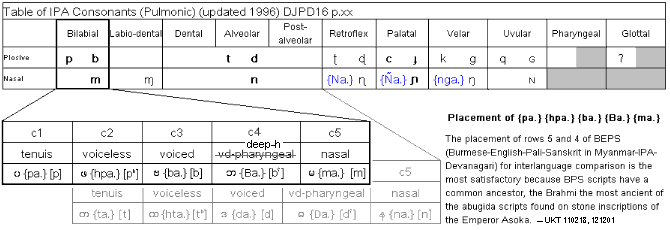
The above table shows two groups of POA (Point of Articulation),
the bilabial and dental-alveolar, extended to accommodate
the c2 and c4 wag-consonants. And the table below shows
the extension of the palatal [![]() {a-hkaung ma}] and velar [
{a-hkaung ma}] and velar [![]() {a-hkaung pyau.}] groups. The
constriction and blocking of the air-passage in bilabial
and dental-alveolar groups are effected by the tongue tip,
whereas that of palatal and velar groups are effected by
the body of the tongue. The very agile tongue tip gives
problems of its own which are different from those presented
by the not-so agile body of the tongue. In fact, in Bur-Myan,
I find for myself that /c/ and /ɟ/ as onsets are
impossible to produce. My attempts to articulate them always
result in /s/ and /z/. However, it is easy to produce them
as codas, the "killed" consonants, represented as
{a-hkaung pyau.}] groups. The
constriction and blocking of the air-passage in bilabial
and dental-alveolar groups are effected by the tongue tip,
whereas that of palatal and velar groups are effected by
the body of the tongue. The very agile tongue tip gives
problems of its own which are different from those presented
by the not-so agile body of the tongue. In fact, in Bur-Myan,
I find for myself that /c/ and /ɟ/ as onsets are
impossible to produce. My attempts to articulate them always
result in /s/ and /z/. However, it is easy to produce them
as codas, the "killed" consonants, represented as
![]() {a.��t} .
{a.��t} .
We find such coda-consonants in disyllabic words such as in
Eng-Lat <success> /sək'ses/, and in Bur-Myan
![]() {�ic~sa}. Of course, in Bur-Myan, the coda-consonant
is given as an
{�ic~sa}. Of course, in Bur-Myan, the coda-consonant
is given as an
![]() {a.��t} where the "flag" is not shown when the word
is spelled as a conjunct. Thus, I have been arguing that in
<success> it could very well be /səc'ses/ in
which case the so-called "double c" becomes the same as the
{a.��t} where the "flag" is not shown when the word
is spelled as a conjunct. Thus, I have been arguing that in
<success> it could very well be /səc'ses/ in
which case the so-called "double c" becomes the same as the
![]() {paaHt.hsing.} - the Pali vertical conjunct.
{paaHt.hsing.} - the Pali vertical conjunct.
A well known Bur-Myan and Pal-Myan conjunct is the
"horizontal conjunct" found in the word for
"education",
![]() {pi�~�a}, where the two
{pi�~�a}, where the two
![]() {�a.} are conjoined horizontally as
{�a.} are conjoined horizontally as
![]() -->
--> ![]() {�a.} resulting in the common spelling
{�a.} resulting in the common spelling
![]() {pa.�a} which must be pronounced continueously
- NOT as {pa.) and {�a}separately. Such horizontal conjuncts lack a name and I propose
to call them
{pa.�a} which must be pronounced continueously
- NOT as {pa.) and {�a}separately. Such horizontal conjuncts lack a name and I propose
to call them
![]() {paaHt.tw�:}.
{paaHt.tw�:}.
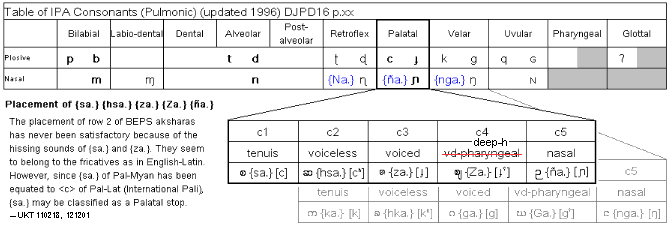
The above table shows the POAs of bilabial [![]() {nhoat-hk�m:}], and dental-alveolar [
{nhoat-hk�m:}], and dental-alveolar [![]() {�wa:}-
{�wa:}-
![]() {�wa:ring:ro:}] groups.
{�wa:ring:ro:}] groups.
It seems that
![]() {hka.} of Pal-Myan is heard differently by Skt-Dev speakers
depending on the phonological environment: sometimes as ख
Kha and at other times क्ष
Ksa . The second sound is found in words like
{hka.} of Pal-Myan is heard differently by Skt-Dev speakers
depending on the phonological environment: sometimes as ख
Kha and at other times क्ष
Ksa . The second sound is found in words like
![]() {�a.r�-hk�t~ta.ra} the second part of which is transcribed as
क्षेत्र kṣetra
(alt. trans.: kShetra) n. field - SpkSkt
क्षेत्र (kShetra) ]
{�a.r�-hk�t~ta.ra} the second part of which is transcribed as
क्षेत्र kṣetra
(alt. trans.: kShetra) n. field - SpkSkt
क्षेत्र (kShetra) ]
Go back extension-IPA-note-b
by UKT
The following are the mappings of Myanmar to IPA:
(Note: In some IPA tables you will see a new column added between Pharyngeal and
Glottal. It is named Epiglottal. In the Fricative row you will find "voiceless
epiglottal fricative" - the small capital ʜ. When I listened to the
sound clip given by Wikipedia on "voiced epiglottal fricative"
http://en.wikipedia.org/wiki/Voiced_epiglottal_fricative 090702,
it sounded like
![]() {hwa}.)
{hwa}.)

In mappings Myanmar to IPA, it is found that
unless labio-dental phonemes and their dedicated graphemes
are introduced into Myanmar, transcription of English into
Burmese become very cumbersome. Since in some English words
the phoneme /f/ is represented by the digraph <ph>,
I suggest that the syllable /fa/ be represented by {hpha.}.
According to my friend U Tun Tint of MLC, such an introduction
"could" be allowed by Burmese-Myanmar grammar,
and accordingly I have introduced two graphemes for f and v :
![]() {hpha.}
from
{hpha.}
from ![]() {hpa.}, and
{hpa.}, and
![]() {bha.}
from
{bha.}
from ![]() {ba.} respectively.
Since the forms are in medial, a change is further made to give the grapheme
basic forms and new Romabama names:
{ba.} respectively.
Since the forms are in medial, a change is further made to give the grapheme
basic forms and new Romabama names:
![]() {fa.} and
{fa.} and
![]() {va.}. You'll note that /f/ is also
not present in Devanagari (and in most Indian languages), and
a new grapheme has been derived from फ (Pha) --> फ़
(Fa) (not from प (Pa)).
{va.}. You'll note that /f/ is also
not present in Devanagari (and in most Indian languages), and
a new grapheme has been derived from फ (Pha) --> फ़
(Fa) (not from प (Pa)).
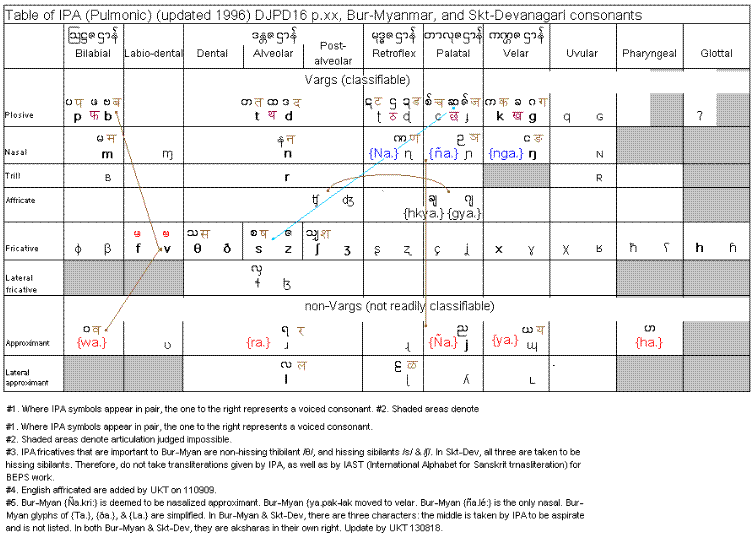
 {hsa.} (palatal plosive approximated by IPA /sʰ/) changing into
{hsa.} (palatal plosive approximated by IPA /sʰ/) changing into  {hsa.} -
{hsa.} -
Go back map-con-note-b
- by UKT

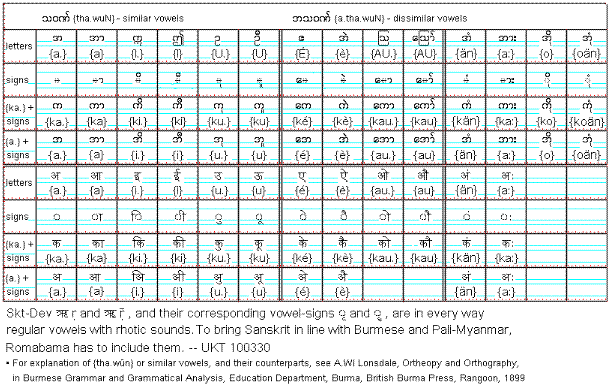
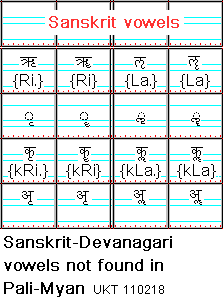
The consonants can combine with medial formers,
![]() {ya.}
{ya.}
![]() {ra.}
{ra.}
![]() {wa.}
{wa.}
![]() {ha.}, to form medials. However,
{ha.}, to form medials. However,
![]() {la.} is said to form medials at one time and it is still
found in the dialect of Tavoy region. We note that the medial formers are all
approximants. Pali
{la.} is said to form medials at one time and it is still
found in the dialect of Tavoy region. We note that the medial formers are all
approximants. Pali
![]() {ra.} more rhotic than Burmese
{ra.} more rhotic than Burmese
![]() {ra.} forms a rhotic medial
where as the Burmese
{ra.} forms a rhotic medial
where as the Burmese
![]() {ra.} on forming
{ra.} on forming
![]() {ra.ric} does not give a r-rolling sound
and the
{ra.ric} does not give a r-rolling sound
and the
![]() {ra.ric} sounds similar to
{ra.ric} sounds similar to
![]() {ya.ping.`}. There is need to use a dedicated
grapheme for the rhotic medial sometimes, and I suggest that for transcription
of words like <cross> :
{ya.ping.`}. There is need to use a dedicated
grapheme for the rhotic medial sometimes, and I suggest that for transcription
of words like <cross> :
� to introduce
, e.g. for {k~ra.} into Romabama and call {ka.ra.hsw�:}. Then, <cross> becomes {k~rau:S}. Another possibility is
� to borrow a "rhotic vowel" from Sanskrit-Devanagari and introduce {Ra.} . Thus, <cross> can be transcripted as {kRau:S} .
- I'm waiting for input from my Burmese-Myanmar peers. As it now stands {kRau:S} seems to be preferred transcription.
In the mappings of vowels, the positions of the Burmese-Myanmar vowels are my
suggestions. I do not expect the mappings to be as reliable as in the case of
the consonants. Because of this I haven't given the Romabama equivalents at this
stage of analysis (090621). You will notice that the Burmese-Myanmar vowels
inside the quadrilateral can be followed by killed consonants and are checked
vowels. I am introducing a "new" grapheme for Burmese-Myanmar mid vowel
{�:} for cases when it is followed by a killed consonant, e.g.,
![]() -->
-->
![]() {�k} .
{�k} .
Since there is correspondence between Myanmar and Devanagari, studying Pali-Devanagari need not be difficult.
After studying the Sanskrit vowels, it came to my mind to "extend" the BEPS, or Bur-Myan, or Pal-Myan vowels by treating the medial formers commonly called semi-vowels as vowels:
vowel-letter
{ya.} --> vowel-sign
{-ya.}/
{ya.ping.}
vowel-letter{ra.} --> vowel-sign
{-ra.}/
{ra.ric}
vowel-letter{ra.} (same form as above) --> vowel-sign
{-Ra.}/
{Ra.ric-kri:} (to show high rhoticity)
vowel-letter{la.} --> vowel-sign
{-la.}/
{la.hsw�:}
vowel-letter{wa.} --> vowel-sign
{-wa.}/
{wa.hsw�:}
vowel-letter{ha.} --> vowel-sign
{-ha.}/
{ha.hto:}
Go back map-vow-note-b
- by UKT
Few people have looked thoroughly inside their mouths. Dentists certainly have
to look inside the mouth. But, theirs like yours are the teeth. I have asked
many the name of the uvula, the most prominent feature in hungry and greedy
animal cartoons. They would say
![]() {a-�i:}
literally the "fruit of the interior mouth". But almost none responded with
{a-�i:}
literally the "fruit of the interior mouth". But almost none responded with
![]() {lya-hking} literally the "beloved of the tongue". Open your mouth wide, but for
a better view why not "cut" your cheeks as is done in the drawing of Gray's Fig.
1014. (Pardon me: it's meant to be a joke.), and you will clearly see inside
your mouth. You'll the places of articulation of the consonants. However, none,
probably including the ancient phoneticians such as Panini
(Pāṇini, पाणिनि ,
{lya-hking} literally the "beloved of the tongue". Open your mouth wide, but for
a better view why not "cut" your cheeks as is done in the drawing of Gray's Fig.
1014. (Pardon me: it's meant to be a joke.), and you will clearly see inside
your mouth. You'll the places of articulation of the consonants. However, none,
probably including the ancient phoneticians such as Panini
(Pāṇini, पाणिनि ,
{pa-Ni.ni.}) (520 � 460 BC) and his predecessor
Yāska यास्कः
{ya-�a.ka.} /
{ya�~�a.ka}
(
http://en.wikipedia.org/wiki/Yaska 080620
- UKT: this link does not work on 110216), has ever
seen the vocal chords in action - in active speech - until
recent times. Thanks to surgery of the throat (because of
cancer and other diseases) we now know what the inside of
the throat looks like and know those vocal parts responsible
for the vowels.
A graphical representation of the POA from various sources is shown below.
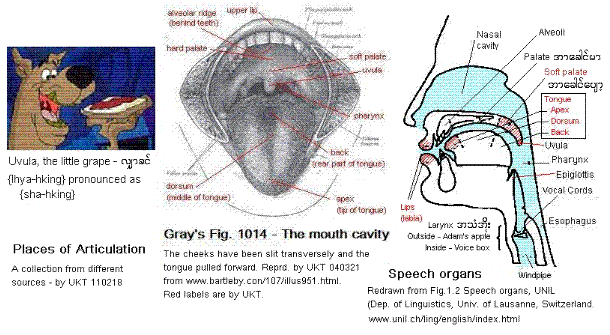
It is common to describe the articulators and the place where each is located. Roach names seven articulators. They are also known as POA (Points of Articulation):
Note: I am very careful on giving the correct Bur-Myan spellings. However, whenever, I cannot find a term I need in any of the dictionaries mentioned as my references, I have to coin it. The reader is requested to check it with the disciplines concerned and to inform me.
Go back POA-pix-note-b
From: English Pronunciation Guide - Learn to Speak English, Part 1
Click on the word (hyperactive in blue usually marked with <)) - but not here) to hear the sound.
There are, unfortunately, no rules for stress in English. There is no way of knowing which syllable or syllables are stressed in any English word. Consequently, you must learn the stress of a word when you learn the word. There is, however, a general tendency in English accentuation that will help you make educated guesses when you meet a new word and do not already know what syllable is stressed.
The great majority of two-syllable words in English are stressed on the first syllable, for example, English <)), second <)), photo <)), upper <)), etc. You should note, however, that sometimes the same word might be stressed on the first syllable to mean one thing and also stressed on the second syllable to mean another, for example, 'produce <)) and pro�duce <)), the first being a noun and the second a verb. There are many examples of this phenomenon, such as 'subject <)) (noun) and sub�ject <)) (verb), 'object <)) (noun) and ob�ject <)) (verb).
Of historical interest is the fact that when determination of syllabic stress in English is related to the origin of the words under discussion. Thus, in the sequence love <)), lovely <)), lovable <)), loveliness <)), lovableness <)), we see that the stress is constant on the first syllable. These are native English words. However, in the sequences, �photograph <)), pho�tography <)), photo�graphic <)) and 'equal <)), e�quality <)), equalization <)), equilit�arian <)), we find the stress shifting from one syllable to another as the word gets longer. Words that follow this stress pattern are from Greek or Latin origin.
Go back stress-note-b
UKT: Was "Vedic Sanskrit" Sanskrit? Or was it a Tibeto-Burmese language similar to "Magadhi"? Or, was it Magadi itself? And, therefore simply call it "Vedic" dropping the suffix "Sanskrit" altogether. How is the Vedic Sanskrit similar to Pali-Myanmar? These are the questions bothering me right now. -- UKT110218 , the 76th birthday.
From: http://en.wikipedia.org/wiki/History_of_India 110218
The history of India begins with evidence of human activity of Homo sapiens as long as 75,000 years ago, or with earlier hominids including Homo erectus from about 500,000 years ago. [UKT �]
Speech, with syntax, is the most important thing that distinguish man from apes. Apes do communicate with each other, but their calls lack syntax. Was Homo erectus (H. erectus) able to speak? It depends on the length of his neck. And if he could, what was his language? -- UKT 110218.
The Soanian is an archaeological culture of the Lower Paleolithic (ca. 500,000 to 125,000 BP) in the Siwalik region of the Indian subcontinent[1]. Contemporary to the Acheulean, it is named after the Soan Valley in the Sivalik Hills, Pakistan. Soanian sites are found along the Sivalik region in present-day India, Nepal and Pakistan.[2] The bearers of this culture were Homo erectus. -- http://en.wikipedia.org/wiki/Soan_Culture 110218
The Bhimbetka rock shelters (भीमबेटका पाषाण आश्रय) are an archaeological World Heritage site located in Raisen District in the Indian state of Madhya Pradesh. The Bhimbetka shelters exhibit the earliest traces of human life in India; a number of analyses suggest that at least some of these shelters were inhabited by man for in excess of 100,000 years. Some of the Stone Age rock paintings found among the Bhimbetka rock shelters are approximately 30,000 years old. -- http://en.wikipedia.org/wiki/History_of_India 110218
In Myanmar, "The Padalin caves are situated at Ywangan Township in Taunggyi, Shan State. In this area, the tools are largely made on pebbles. They are crude and without marks of secondary flaking or retouching, resembling the palaeolithic tools. The occurrence of Potsherds characterizes the neolithic pattern of culture. The mural paintings are seen in the eastern cave, No-1. The rest are animal figures, bulls, bisons, a deer, hinds of elephants, a huge fish." -- http://culturemyanmar.org/pages/doa_development%20cultural%20period%20in%20myanmar.htm 110218
UKT: Of course, those who had made the cave paintings were humans. But what were their speeches?
The Indus Valley Civilization, which spread and flourished in the northwestern part of the Indian subcontinent from c. 3300 to 1300 BCE, was the first major civilization in India. A sophisticated and technologically advanced urban culture developed in the Mature Harappan period, from 2600 to 1900 BCE. This Bronze Age civilization collapsed before the end of the second millennium BCE and was followed by the Iron Age Vedic Civilization, which extended over much of the Indo-Gangetic plain and which witnessed the rise of major polities known as the Mahajanapadas. In one of these kingdoms, Magadha, Mahavira and Gautama Buddha were born in the 6th or 5th century BCE and propagated their śramanic philosophies.
UKT: Who were the people of the Bronze age in India? "The Bronze Age in South Asia begins around 3000 BC (Harappan 1) in North India, and in the end gives rise to the Indus Valley Civilization, which had its mature period between 2600 BC and 1900 BC. It continues into the Rigvedic period, the early part of the Vedic period. It is succeeded by the Indian Iron Age, beginning around 1000 BC. -- http://en.wikipedia.org/wiki/Bronze_Age_India 110218
UKT: When the word "bronze" is mentioned by non-chemists, do we know what they mean. It could very well be "brass" an alloy of copper and zinc. Bronze is an alloy of copper and tin. When copper ore containing zinc is made into metal the colour is more yellow than when a copper ore containing tin is used. Hence, the Bur-Myan terms
{kr�:ni} 'copper' (reddish),
{kr�:wa} 'brass' (yellowish), and
{kr�:�o} 'brozne' (greyish). Unfortunately, at this late age of mine, I would not be able to analyze the alloys found in each culture. Copper ore found in the areas of Myanmar close to the Indian border is more abundant in zinc than in tin, and so analyzing the metal artifacts of the Indian bronze age might throw some light on whether the ancient Indians had imported the ore from Myanmar or not. Close trade links would suggest close cultural links and perhaps close linguistic links. Since Bur-Myan has quite a lot of lateral sounds, and since Vedic had lateral vowels, could we conclude that Vedic was also a Tibeto-Burman language linked to Bur-Myan. In this case, Pal-Myan would be more close to Vedic than to Classical Sanskrit. Please note as a material scientist, I am careful about suggestions, and so my suggestions above should be to be nothing more than suggestions - not even hypotheses nor theories. -- UKT 110218
From: http://en.wikipedia.org/wiki/Vedic_Sanskrit 110216
Edited by UKT to include Skt-Dev spellings and other notes.
Vedic Sanskrit is an Old Indic language. It is an archaic form of Sanskrit, an early descendant of Proto-Indo-Iranian. It is closely related to Avestan, the oldest preserved Iranian language. Vedic Sanskrit is the oldest attested language of the Indo-Iranian branch of the IE (Indo-European) family.
UKT: Was Vedic an IE? IE languages do not have many laterals, whereas Vedic has them similar to Burmese which has quite a few: {la.}; {lya.}, {lwa.}, {lha.}; {lhya.}, {lhwa.} . This should be compared to English which has only one or possibly two.
Vedic Sanskrit is the language of the Vedas, texts compiled over the period of early-to-mid 2nd to mid 1st millennium BCE. Vedic Sanskrit has been orally preserved as a part of the Śrauta tradition of Vedic chanting, predating the advent of alphabetic writing in India by several centuries. For lack of both epigraphic evidence and an unboken manuscript tradition, Vedic Sanskrit can be considered a reconstructed language. Especially the oldest stage of the language, Rigvedic Sanskrit, the language of the hymns of the Rigveda, is preserved only in a redacted form several centuries younger than the texts' composition, and recovering its original form is a matter of linguistic reconstruction.
... ... ...
Early Vedic society consisted of largely pastoral groups, with late Harappan urbanization having been abandoned. After the time of the Rigveda, Aryan society became increasingly agricultural and was socially organized around the four social class or varnas, वर्ण varṇa .
The terms Varna (general classification based on occupation) and Jati (caste) are two distinct concepts. Varna (from Sanskrit, literally "arrangement") is usually a unification of all the Hindu castes or jatis into four groups: Brahmin, Kshatriya, Vaishya, Shudra. It is sometimes also used to refer to this unification into one of several varna-sankaras वर्ण संकर. Jati ( community) is an endogamous group. Generally a sub-community is divided into exogamous groups based on same gotras गोत्र. The classical authors scarcely speak of anything other than the varnas. Indologists sometimes confuse the two. -- http://en.wikipedia.org/wiki/Varna_Hinduism 110302
In addition to the Vedas, the principal texts of Hinduism, the core themes of the Sanskrit epics Ramayana and Mahabharata are said to have their ultimate origins during this period. [20] The early Indo-Aryan presence probably corresponds, in part, to the Ochre Coloured Pottery culture in archaeological contexts. [21]
The Kuru kingdom [22] corresponds to the Black and Red Ware and Painted Grey Ware cultures and to the beginning of the Iron Age in northwestern India, around 1000 BCE, as well as with the composition of the Atharvaveda, the first Indian text to mention iron, as śyāma ayas, literally "black metal." The Painted Grey Ware culture spanned much of northern India from about 1100 to 600 BCE.[21] The Vedic Period also established republics such as Vaishali, which existed as early as the 6th century BCE and persisted in some areas until the 4th century CE. The later part of this period corresponds with an increasing movement away from the previous tribal system towards the establishment of kingdoms, called mahajanapadas.
... ... ...
From ca. 600 BCE, in the classical period of Iron Age Ancient India, Vedic Sanskrit gave way to Classical Sanskrit as defined by the grammar of Pāṇini.
UKT: The following map, from http://en.wikipedia.org/wiki/History_of_India 110218, shows Nanda Empire and other areas in northern India in which Classical Sanskrit was spoken at least by the educated. (fact need to be further checked. - UKT 110218)
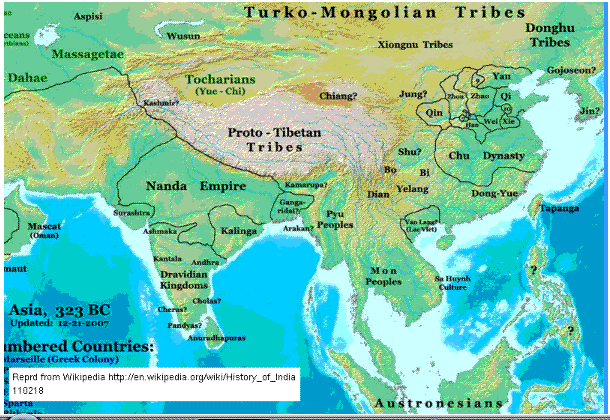
Go back vedic-note-b
End of TIL file